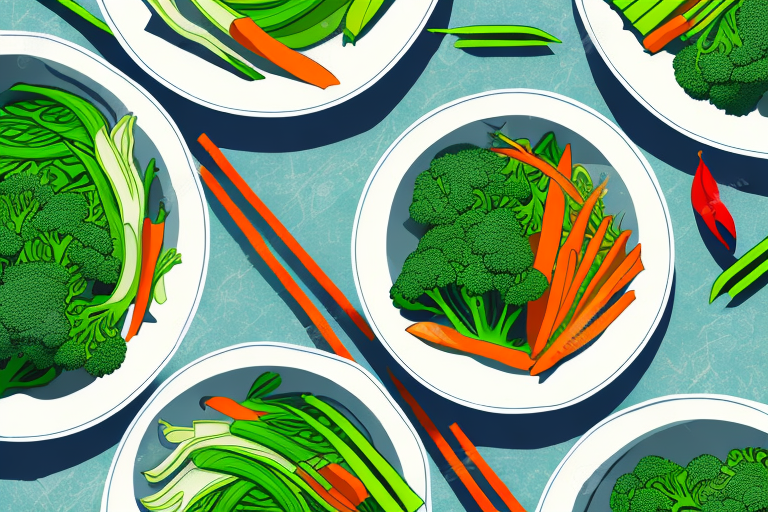Yu Choy is a vegetable with a unique flavor and texture that makes it popular for stir-fry dishes. It is readily available in most Chinese supermarkets, and is a great way to add a little something extra to your meals. In this guide, we provide an easy-to-follow step-by-step recipe for cooking yu choy.
What You’ll Need
Before you begin cooking your yu choy, there are a few items you’ll need to have on hand. These items include: yu choy, a stir-fry pan or wok, cooking oil, garlic, ginger, soy sauce, and sesame oil. You may also want to include additional ingredients, such as onions, carrots, or mushrooms, depending on your preferences.
It is important to make sure that all of your ingredients are prepped and ready to go before you start cooking. This means that you should have your yu choy washed and cut into bite-sized pieces, your garlic and ginger minced, and your vegetables chopped. Having everything prepped ahead of time will make the cooking process much smoother and faster.
Preparing the Yu Choy
Once you have all the necessary ingredients, you can start prepping your yu choy. Start by cleaning the leaves and stem of the yu choy with water. Next, chop the leaves and stem into smaller pieces, approximately 1-inch chunks. Once the yu choy is prepared, set it aside and move onto the next step.
Before you begin cooking the yu choy, you should also prepare the other ingredients. Peel and mince the garlic, and cut the ginger into thin slices. Slice the mushrooms and set aside. Once all the ingredients are prepped, you can begin cooking the yu choy.
Stir-Frying the Yu Choy
Heat up a stir-fry pan or wok over medium-high heat. Add your cooking oil and wait for it to heat up before adding your chopped garlic and ginger. Let this cook for about one minute, stirring occasionally. Then add your prepared yu choy and stir-fry for a few minutes – about 5 minutes should be enough. You may need to add a bit more oil, depending on how much food you’re cooking. Once the yu choy is cooked through, reduce the heat and add in your soy sauce and sesame oil to finish off the dish.
Serve the stir-fried yu choy with steamed white rice or noodles for a complete meal. You can also add other vegetables to the stir-fry, such as bell peppers, mushrooms, or carrots. For a spicier version, add some chili flakes or a dash of hot sauce. Enjoy your stir-fried yu choy!
Adding Flavor and Texture
To add extra flavor and texture to your dish, you can include additional ingredients such as onions, mushrooms, or carrots. If you choose to include any of these ingredients, they should be prepped and cooked along with the garlic and ginger in the previous step. Add them to the wok with the garlic and ginger and stir-fry until they are cooked through.
You can also add other vegetables such as bell peppers, broccoli, or zucchini. These vegetables should be added after the onions, mushrooms, and carrots have been cooked. Stir-fry them for a few minutes until they are tender and cooked through. You can also add other seasonings such as soy sauce, sesame oil, or chili paste to give your dish an extra kick of flavor.
Serving Suggestions
Yu choy is best served with steamed white rice or noodles. It is often included as part of an Asian-style stir-fry meal, but you can also serve it as a side dish or as part of a salad. To mix up flavors and textures, combine the yu choy with other vegetables such as bell peppers, snow peas, and baby corn.
Tips and Tricks for Cooking Yu Choy
When cooking yu choy, remember to cook it quickly over high heat in order to preserve its crisp texture and natural flavor. Additionally, be sure to season generously with soy sauce and sesame oil so that the vegetables retain their flavor after cooking. Since yu choy is a delicate vegetable, be careful not to overcook it – it should only take a few minutes until it is cooked through.
Variations on the Recipe
This recipe is just a guideline – feel free to play around with ingredients and flavors by adding your favorite seasonings or sauces to the dish. You can make it spicier by adding chili paste or give it a Thai twist with some lemongrass and lime juice. Be creative and experiment to create your own unique flavors!
Common Questions About Cooking Yu Choy
Can I cook yu choy with other vegetables? Yes! As mentioned above, adding additional vegetables is a great way to add flavor and texture to your dish. What should I do if my yu choy is too tough? If your yu choy has gotten too tough while cooking, reduce the heat on your wok and add a touch more oil. This should bring back some of the vegetable’s natural tenderness. Is there any way to make this dish healthier? Yes – swap out your regular cooking oil for a healthier option such as olive or canola oil for added health benefits.













